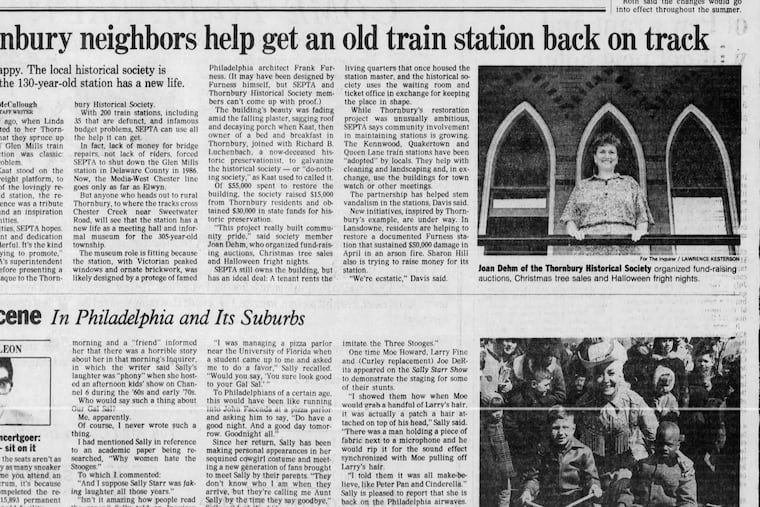From the Inquirer archives: Sprucing up a SEPTA station in Delco
The building's beauty was fading amid the falling plaster, sagging roof and decaying porch.

This article originally appeared in The Inquirer on July 10, 1992
About a decade ago, when Linda Kaat first suggested to her Thornbury neighbors that they spruce up SEPTA’s rundown Glen Mills train station, the reaction was classic: That’s SEPTA’s problem.
Yesterday, as Kaat stood on the wooden porch (freight platform, to you train buffs) of the lovingly restored, 130-year-old station, the result of her persistence was a tribute to the township and an inspiration for other communities.
Lots of communities, SEPTA hopes.
“The commitment and dedication down here is wonderful. It’s the kind of thing we’re trying to promote,” John Davis, SEPTA’s superintendent of stations, said before presenting a commemorative plaque to the Thornbury Historical Society.
With 200 train stations, including 35 that are defunct, and infamous budget problems, SEPTA can use all the help it can get.
In fact, lack of money for bridge repairs, not lack of riders, forced SEPTA to shut down the Glen Mills station in Delaware County in 1986. Now, the Media-West Chester line goes only as far as Elwyn.
But anyone who heads out to rural Thornbury, to where the tracks cross Chester Creek near Sweetwater Road, will see that the station has a new life as a meeting hall and informal museum for the 305-year-old township.
The museum role is fitting because the station, with Victorian peaked windows and ornate brickwork, was likely designed by a protege of famed Philadelphia architect Frank Furness. (It may have been designed by Furness himself, but SEPTA and Thornbury Historical Society members can’t come up with proof.)
The building’s beauty was fading amid the falling plaster, sagging roof, and decaying porch when Kaat, then owner of a bed and breakfast in Thornbury, joined with Richard B. Luchenbach, a now-deceased historic preservationist, to galvanize the historical society — or “do-nothing society,” as Kaat used to called it.
Of $55,000 spent to restore the building, the society raised $15,000 from Thornbury residents and obtained $30,000 in state funds for historic preservation.
“This project really built community pride,” said society member Joan Dehm, who organized fundraising auctions, Christmas tree sales, and Halloween fright nights.
SEPTA still owns the building, but has an ideal deal: A tenant rents the living quarters that once housed the station master, and the historical society uses the waiting room and ticket office in exchange for keeping the place in shape.
While Thornbury’s restoration project was unusually ambitious, SEPTA says community involvement in maintaining stations is growing. The Kennwood, Quakertown, and Queen Lane train stations have been “adopted” by locals. They help with cleaning and landscaping and, in exchange, use the buildings for town watch or other meetings.
The partnership has helped stem vandalism in the stations, Davis said.
New initiatives, inspired by Thornbury’s example, are under way. In Lansdowne, residents are helping to restore a documented Furness station that sustained $50,000 damage in April in an arson fire. Sharon Hill also is trying to raise money for its station.
“We’re ecstatic,” Davis said.